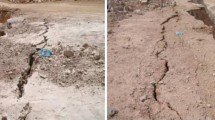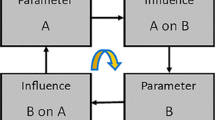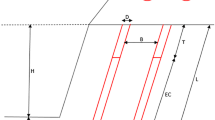Abstract
Most blasting operations are associated with various forms of energy loss, emerging as environmental side effects of rock blasting, such as flyrock, vibration, airblast, and backbreak. Backbreak is an adverse phenomenon in rock blasting operations, which imposes risk and increases operation expenses because of safety reduction due to the instability of walls, poor fragmentation, and uneven burden in subsequent blasts. In this paper, based on the basic concepts of a rock engineering systems (RES) approach, a new model for the prediction of backbreak and the risk associated with a blast is presented. The newly suggested model involves 16 effective parameters on backbreak due to blasting, while retaining simplicity as well. The data for 30 blasts, carried out at Sungun copper mine, western Iran, were used to predict backbreak and the level of risk corresponding to each blast by the RES-based model. The results obtained were compared with the backbreak measured for each blast, which showed that the level of risk achieved is in consistence with the backbreak measured. The maximum level of risk [vulnerability index (VI) = 60] was associated with blast No. 2, for which the corresponding average backbreak was the highest achieved (9.25 m). Also, for blasts with levels of risk under 40, the minimum average backbreaks (<4 m) were observed. Furthermore, to evaluate the model performance for backbreak prediction, the coefficient of correlation (R 2) and root mean square error (RMSE) of the model were calculated (R 2 = 0.8; RMSE = 1.07), indicating the good performance of the model.










Similar content being viewed by others
References
Aghajani Bazzazi A, Mansouri H, Ebrahimi Farsangi MA, Atashpanjeh A (2006) Application of controlled blasting (pre-splitting) using large diameter holes in Sarcheshmeh copper mine. In: Proceedings of the 8th international symposium on rock fragmentation by blasting, Santiago, Chile, May 2006, pp 388–392
Benardos AG, Kaliampakos DC (2004) A methodology for assessing geotechnical hazards for TBM tunnelling—illustrated by the Athens Metro, Greece. Int J Rock Mech Min Sci 41:987–999
Berta G (1990) Explosives: an engineering tool. Italesplosivi, Millano
Bhandari S (1997) Engineering rock blasting operations. Balkema, Rotterdam
Cancelli I, Crosta G (1993) Hazard and risk assessment in rockfall prone areas. In: Skipp BO (ed) Risk and reliability in ground engineering. Thomas Telford, London, pp 177–190
Enayatollahi I, Aghajani Bazzazi A (2010) Evaluation of salt-ANFO mixture in back break reduction by data envelopment analysis. In: Proceedings of the 9th international symposium on rock fragmentation by blasting, Granada, Spain, August 2009, pp 127–133
Firouzadj A, Farsangi MAE, Mansouri H, Esfahani SK (2006) Application of controlled blasting (pre-splitting) in Sarcheshmeh Copper Mine. In: Proceedings of the 8th international symposium on rock fragmentation by blasting, Santiago, Chile, May 2006, pp 383–387
Gate WCB, Ortiz LT, Florez RM (2005) Analysis of rockfall and blasting backbreak problems, US 550, MolasPass, CO. In: Proceedings of the 40th U.S. symposium on rock mechanics, ARMA/USRMS, Anchorage, Alaska, June 2005, vol 5, pp 671–680
Hudson JA (1992) Rock engineering systems: theory and practice. Ellis Horwood, Chichester
Hustrulid WA (1999) Blasting principles for open pit mining: vol 1, general design concepts. Balkema, Rotterdam
Hustrulid WA, Lu WB (2002) Some general design concepts regarding the control of blast-induced damage during rock slope excavation. In: Proceedings of the 7th international symposium on rock fragmentation by blasting, Beijing, China, August 2002, pp 595–604
Iverson SR, Hustrulid WA, Johnson JC, Tesarik D, Akbarzadeh Y (2010) The extent of blast damage from a fully coupled explosive charge. In: Proceedings of the 9th international symposium on rock fragmentation by blasting, Granada, Spain, August 2009, pp 459–468
Jimeno CL, Jimeno EL, Carcedo FJA (1995) Drilling and blasting of rocks. Balkema, Rotterdam
Kilebrant M, Norrgard T, Jern M (2010) The size of the damage zone in relation to the linear charge concentration. In: Proceedings of the 9th international symposium on rock fragmentation by blasting, Granada, Spain, August 2009, pp 449–457
Konya CJ, Walter EJ (2003) Rock blasting and overbreak control. National Highway Institute, Arlington
Konya CJ, Walter EJ (1991) Rock blasting and overbreak control. United States Department of Transportation, McClean
Langefors U, Kihlstrom B (1978) The modern technique of rock blasting. Wiley, New York
Latham J-P, Lu P (1999) Development of an assessment system for the blastability of rock masses. Int J Rock Mech Min Sci 36:41–55
Lu P, Hudson JA (1993) A fuzzy evaluation approach to the stability of underground excavations. In: Ribeiro L, Sousa E, Grossmann NF (eds) ISRM international symposium: EUROCK’93, Lisbon, Portugal, June 1993. Balkema, Rotterdam, pp 615–622
Lu WB, Hustrulid WA (2002) Evaluation of the effect of blast-induced damage control during rock slope excavation at Three Gorges Project in China. In: Proceedings of the 7th international symposium on rock fragmentation by blasting, Beijing, China, August 2002, pp 765–771
Lu P, Latham J-P (1994) A continuous quantitative coding approach to the interaction matrix in rock engineering systems based on grey systems approaches. In: Proceedings of 7th international congress of the IAEG, Lisbon, Portugal, September 1994. Balkema, Rotterdam, pp 4761–4770
Mazzoccola DF, Hudson JA (1996) A comprehensive method of rock mass characterization for indicating natural slope instability. Q J Eng Geol 29:37–56
Monjezi M, Dehghani H (2008) Evaluation of effect of blasting pattern parameters on backbreak using neural networks. Int J Rock Mech Min Sci 45:1446–1453
Monjezi M, Rezaei M, Yazdian A (2010) Prediction of backbreak in open-pit blasting using fuzzy set theory. Expert Syst Appl 37:2637–2643
Monjezi M, Amini Khoshalan H, Yazdian Varjani A (2012) Prediction of flyrock and backbreak in open pit blasting operation: a neuro-genetic approach. Arab J Geosci 5:441–448. doi:10.1007/S12517-010-0185-3
Ouchterlony F, Olsson M, Svärd J (2010) Crack lengths or blast damage from string emulsion and electronic detonators. In: Proceedings of the 9th international symposium on rock fragmentation by blasting, Granada, Spain, August 2009, pp 469–480
Scoble MJ, Lizotte YC, Paventi M, Mohanty BB (1997) Measurement of blast damage. Min Eng 49:103–108
Shin HS, Kwon YC, Jung YS, Bae GJ, Kim YG (2009) Methodology for quantitative hazard assessment for tunnel collapses based on case histories in Korea. Int J Rock Mech Min Sci 46:1072–1087
Singh PK, Roy MP, Joshi A, Joshi V-P (2010) Controlled blasting (pre-splitting) at an open-pit mine in India. In: Proceedings of the 9th international symposium on rock fragmentation by blasting, Granada, Spain, August 2009, pp 481–489
SRK Consulting Engineers and Scientists (2008) Sungun copper project, mining geotechnics and slope design studies, final report. Sungun Copper Company
Zhang JC, Chang C (1999) On damage mechanism of micro crack zone in rock blasting and its measurements. In: Proceedings of the 6th international symposium on rock fragmentation by blasting, Johannesburg, South Africa, August 1999, pp 359–363
Acknowledgments
The authors wish to express their gratitude to Sungun copper mine management for their appreciable cooperation in the field measurements.
Author information
Authors and Affiliations
Corresponding author
Rights and permissions
About this article
Cite this article
Faramarzi, F., Ebrahimi Farsangi, M.A. & Mansouri, H. An RES-Based Model for Risk Assessment and Prediction of Backbreak in Bench Blasting. Rock Mech Rock Eng 46, 877–887 (2013). https://doi.org/10.1007/s00603-012-0298-y
Received:
Accepted:
Published:
Issue Date:
DOI: https://doi.org/10.1007/s00603-012-0298-y




